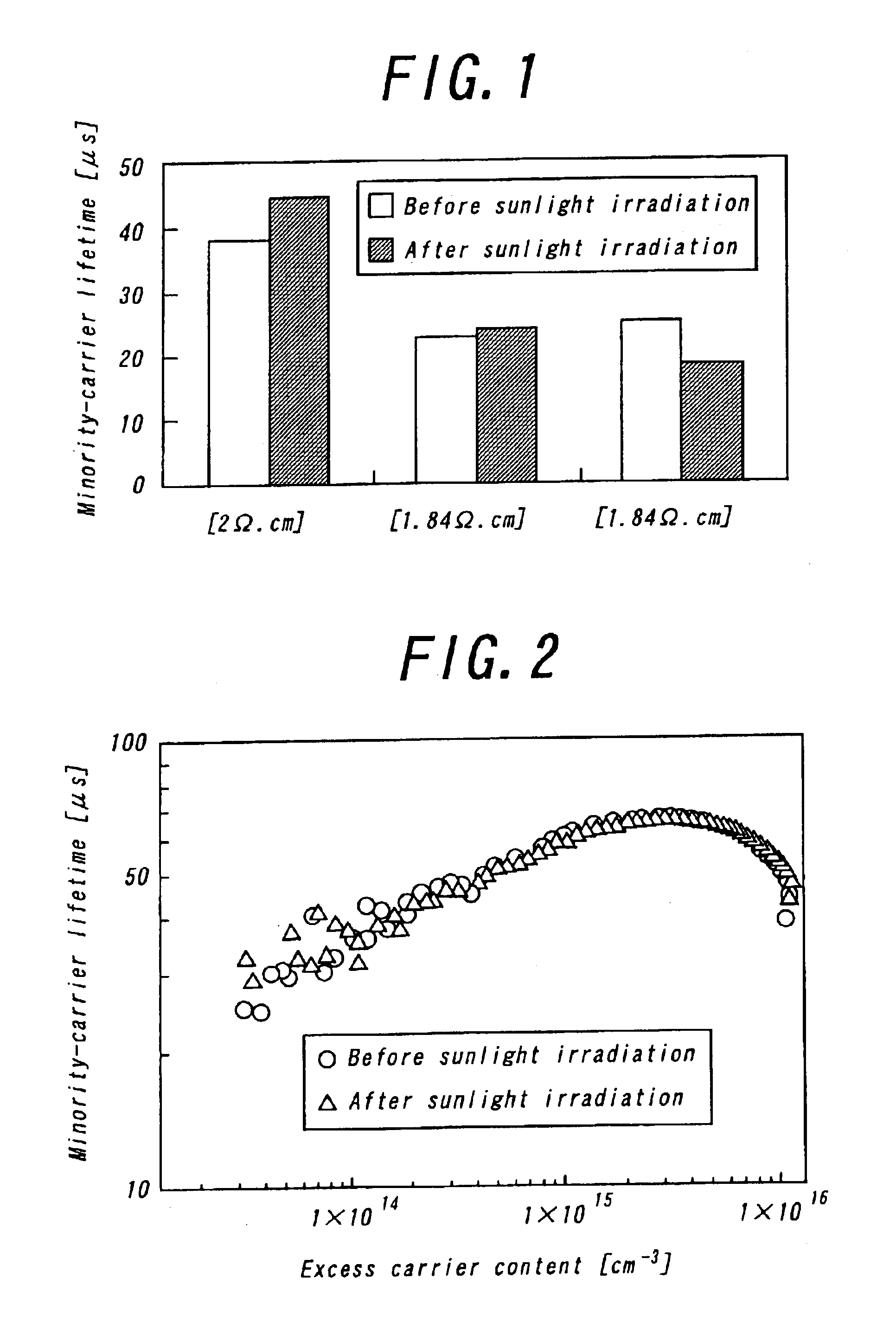Method for producing a polycrystalline silicon, polycrystalline silicon and solar cell
a technology of polycrystalline silicon and solar cells, applied in the direction of final product manufacture, crystal growth process, climate sustainability, etc., can solve the problems of deterioration of various performances and deterioration of carrier lifetime, and achieve the effect of not almost deteriorating conversion efficiency and optical and electrical properties such as minority carrier lifetimes
- Summary
- Abstract
- Description
- Claims
- Application Information
AI Technical Summary
Benefits of technology
Problems solved by technology
Method used
Image
Examples
example 1
[0027]4.5 kg of silicon raw material and 0.25 g (2×10−3 atomic %) of gallium metal were charged into a quartz crucible of which inner surface is coated with a mold lubricant. The mixture was heated to 1550° C. under an Ar gas atmosphere to melt the silicon raw material. After the melting, the crucible was cooled down at a rate of 1° C. / min to crystallize the melted silicon raw material. The resultant crystalline silicon ingot was cut off, and then, the cross section of the silicon ingot was observed. As a result, it was confirmed that in the silicon ingot, polycrystalline boundaries were created vertically, and thus, silicon crystals were created in columnar.
[0028]Then, the polycrystalline silicon ingot was cut off with a wire saw to make a substrate with a thickness of 300 μm. In this case, the resistivity of the polycrystalline silicon ingot was within a range of about 1-2 Ωcm, and decreased in the upper portion thereof.
[0029]In order to remove the slice damaged layer formed at th...
example 2
[0034]A Ga-doped polycrystalline silicon ingot was made in the same manner as in Example 1, and then, cut off with a wire saw to make three substrates with a thickness of 300 μm. The resistivities of the substrates were 2 Ωcm, 1.84 Ωcm and 1.84 Ωcm, respectively.
[0035]Then, the substrates were annealed at a temperature of 200° C. for 10 minutes under an inert gas atmosphere. Thereafter, a simulated-sunlight (spectrum: AM1.5, intensity: 100 m W / cm2) was irradiated onto the substrates for 12 hours by means of the optical conductivity attenuating method to measure the minority-carrier lifetime of the substrates, respectively. The measurement result was drawn in FIG. 1. As is apparent from FIG. 1, the minority-carrier lifetime of the annealed substrates are not almost changed after the long irradiation of 12 hours.
[0036]Then, the relation between the minority-carrier lifetime and the excess carrier contents of the substrates made of the polycrystalline silicon was investigated by means ...
example 3
[0037]4 kg of silicon raw material, 0.25 g (2×10−3 atomic %) of gallium metal and a predetermined amount of silicon oxide were charged into the quartz crucible. The mixture was heated and melted and then, a crystalline silicon ingot was made in the same manner as in Example 1. The crystalline silicon ingot was cut off to make a substrate with a thickness of 300 μm. The oxygen content of the substrate was 1018 / cm3, and the yield stress of the substrate at a temperature of 800° C. was 40 MPa. In contrast, the oxygen content of the substrate made in Example 1 was 1016 / cm3, and the yield stress of the substrate was 15 MPa.
[0038]In this way, if the oxygen content of the polycrystalline silicon increases, the crystal strength of the polycrystalline silicon can increase. Therefore, if a thinner substrate is made from the oxygen-including poly-crystalline silicon, the mechanical strength can be enhanced sufficiently.
PUM
| Property | Measurement | Unit |
|---|---|---|
| temperature | aaaaa | aaaaa |
| thickness | aaaaa | aaaaa |
| thickness | aaaaa | aaaaa |
Abstract
Description
Claims
Application Information
 Login to View More
Login to View More - R&D
- Intellectual Property
- Life Sciences
- Materials
- Tech Scout
- Unparalleled Data Quality
- Higher Quality Content
- 60% Fewer Hallucinations
Browse by: Latest US Patents, China's latest patents, Technical Efficacy Thesaurus, Application Domain, Technology Topic, Popular Technical Reports.
© 2025 PatSnap. All rights reserved.Legal|Privacy policy|Modern Slavery Act Transparency Statement|Sitemap|About US| Contact US: help@patsnap.com

